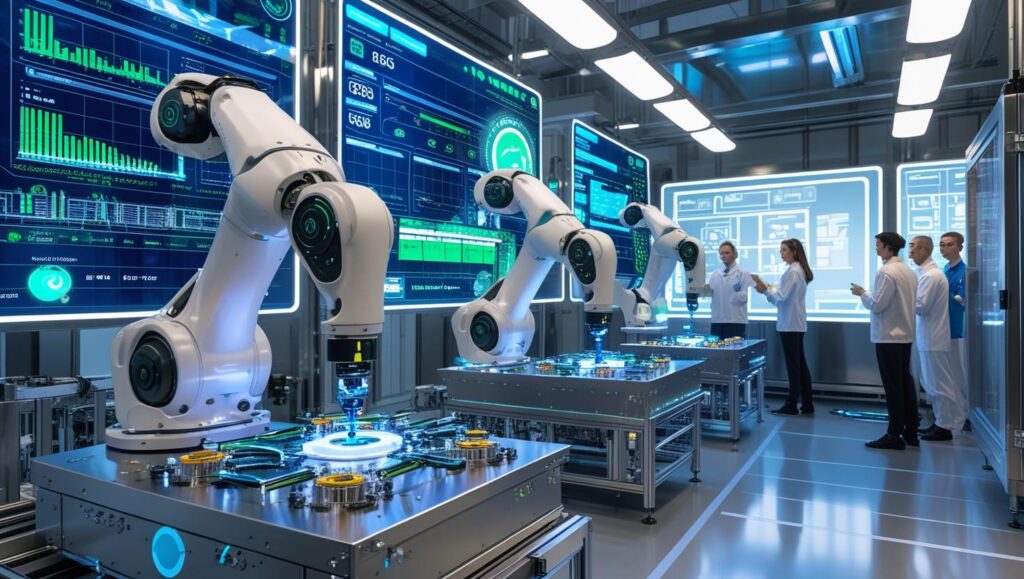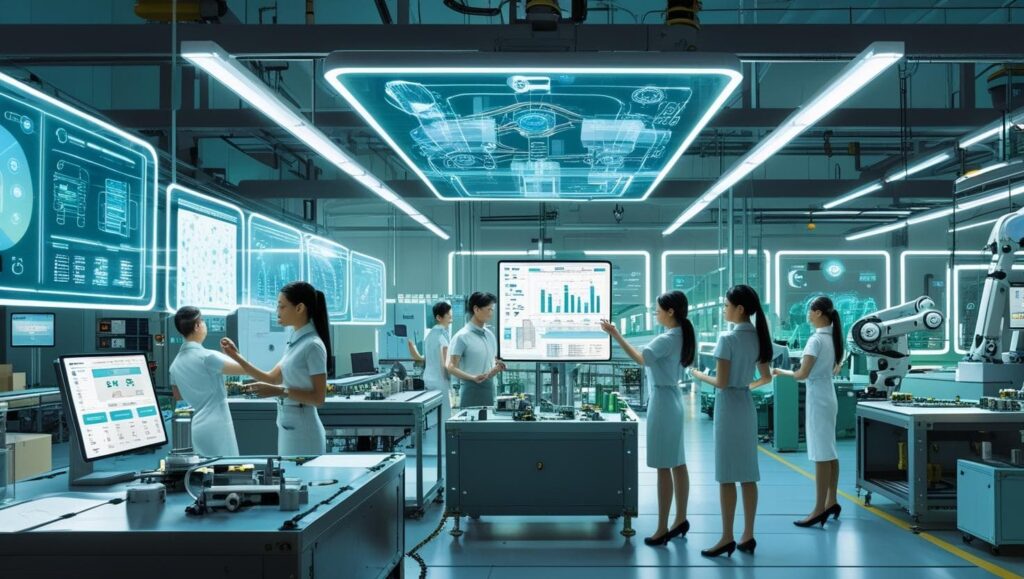

When you think of AI in manufacturing, the common imagination is of a robot bolting down nuts on an assembly line. That mental picture, while undeniable, is a case of an older age. The landscape has turned into something else entirely. Generative AI use cases in manufacturing are transforming product design and simulation.
The current form of AI continues to learn and adapt. It makes recommendations on the basis of its experience it gained while getting trained on data sets.
Tomorrow’s factory will highly help avoiding small and big errors. Just imagine how wonderfully Ai can help in terms of work distribution and load management. Ai will divide workloads around without giving you a headache.
All in all, AI doesn’t just come down to smart coding that makes our gadgets shine. In essence, it is about taking old risks out while managing new risks which in fact improve outputs you can see and measure.
Let’s read more!

We’re able to see a lot of AI use cases in the manufacturing industry today, and the future has a lot more to bring.
Manufacturers will see AI working live in their shop floor today, as compared to merely seeing it in articles and headlines. Robots used to scan items for small dents. Now an algorithm presented by a camera will locate any flaws at much greater accuracy and much quicker than any human.
Data drives everything. AI can consume that data and recognize the low-key irregularities more quickly than a human. It is sharp enough to pinpoint problems in the first place. Just imagine how much time can be saved through it.
Once a designer used to carve a prototype out of timber, but now a software designer can develop a working 3-D model over a single coffee break. That’s the difference AI has brought to the manufacturing industry.
Manufacturers are always on time, on budget, and avoiding scrap, while somehow increasing quality expectations quarter after quarter. Factories today need to do more with less. Less time. Less cost. Less waste. But the pressure to deliver better products is growing.
This is where AI steps in.
AI helps manufacturers
A decision that took hours now takes minutes, and that timing difference highly impacts payroll and logistics. Machine learning algorithms have learned to predict the wear on gearboxes, and save manufacturers from unplanned downtime. There is no doubt AI ML use cases in manufacturing improve quality control and predictive maintenance.
Now let’s take a quick look at how AI is silently reinventing factories.
Production floors are common with cheap sensors that can be plugged into old existing lathes and presses. Once installed, a simple off-the-shelf algorithm monitors the on, off, clicks, and hisses. This checks if there is extra heat or slow gear movement and alerts an engineer before something breaks. The techs come in, twist a bearing or two, and the line continues to move the work during that time.
Previously, fast motion cameras scanned the conveyor while sending moving images to a new AI trained on photographs of samples without defects. A colour variation, a new dent, or absence of a screw triggers immediate violation alert and reports nearby humans . So, the machine is modified to avoid failure next time.
Machines like printers, conveyors, and CNC lathes send updates to each other using Wi-Fi. But most people don’t look at this information or pay attention to it during the day.
The AI dashboards watch the large flow of messages between machines. They change settings and add new tasks without stopping the workers or the production line. Problems that were stressful before now feel easy to handle.
Trends, traffic cams, bar-room banter, even the knots that form in major shipping lanes. AI gulps all of that up all at once. From that crush of data it gives useful suggestions about batch sizes, shelf heights, and when to hit reorder.
AI helps companies avoid having too much stock in the warehouse or empty shelves in stores. It keeps things moving smoothly and helps the business stay profitable.
Fresh software is reducing the old trial-and-error cycle. One click brings in half a dozen nifty sketches and runs them all through a virtual stress test and highlights the strongest candidate. That kind of speed reduces weeks of work and catches mistakes before they leave the screen.
Manufacturing plants are leaning into artificial intelligence to monitor, and then ration how much power they devour. The system identifies peak hours and gluttonous machines, and offers real-time suggestions that reduce the monthly bill. AI can also turn off idle machines automatically. This supports both cost savings and sustainability goals.
An AI engine that is full of memory reads customer orders in real-time and feeds new spec information straight to the floor so that custom parts keep rolling off on time. Seat trims in one plant and surgical grips in another can change colours or textures mid-queue, and everybody keeps working.

Here are a few big companies already using AI in manufacturing-and what they are doing.
Bosch has taught its assembly robots to think ahead, monitoring their own pulses and vibrations until something feels “off.” The end result has been fewer surprise shutdowns and purely coincidentally, a reasonable reduction in money spent on late-night emergency repairs.
BMW installs AI cameras for the purpose of scanning along the assembly line. The lens takes its time to assure that every panel and weld is all set, looking for pinprick defects long before a worker can even blink their eyes.
Foxconn, which makes electronics like iPhones, uses AI to monitor workflows and optimize energy use across its factories.. A silent digital hand is always at work keeping the rhythm within the work in the factory, even when human elaboration is out of the picture.
General Electric relies on its own AI models to manage a global supply chain.
The AI plans shipping routes, sees that boats are going to be late before they’ve even left port, and even changes orders so that the product ends up in the right place at the right time.
You don’t need to build your own AI system from scratch. Start small and grow as you see results.
Here’s a step-by-step path:
Identify one clear pain-point on the factory floor. This might be missed quality checks, a machine that periodically stalls or energy bills rising every month. Stick to the simple stuff; nothing creates clarity better than quick wins.
Gather any evidence you have. Images of defective parts, timestamped sensor logs, handwritten maintenance records. Clean the raw data first. Sparkling data teaches algorithms better than a messy pile.
There are dozens of off-the-shelf types of technology platforms now in the marketplace. Siemens MindSphere and IBM Watson both include toolkits for manufacturing; Microsoft’s Azure Factory Asset Center is already communicating with shop devices. Vendors like WebOsmotic will even build a dashboard for you if you choose to go that route.
Keep the first experiment to one line or maybe even one machine and then just watch. Tweak thresholds, cull through the alerts, gravitate towards operator feedback, and then scale. The more patient you can be, the longer the system will exist organically.
You will begin the rollout in one runway or one workshop and monitor it to see how it sticks. As your confidence grows, slide it into the next runway, to the next workshop, and so on and coach the crew to make sure everyone remains on the same page.
The idea of implementing AI growing in factories is appealing, but road bumps will appear. Bad data or lost reports could confuse the algorithm in a split second. And people will have to ramp up as well; the workers will need to have the information to experiment first before they settle into productive use of dashboards.
These challenges can be easily managed with proper planning and the right partners.
WebOsmotic demystifies artificial intelligence for manufacturers. You don’t have to be a PhD to improve your production line, maintain or improve quality, or avoid machine challenges; we design tools that are intelligent, simple, and shockingly useful.
One-size-fits-all means nothing works anywhere. No two factories are the same. That’s why we take time to understand your setup and create a solution just for you.
Steel mill in Poland, electronics factory in Mexico, a well-known automotive facility in Detroit – they have all reported new speed, better safety and real space for innovation because AI has become a normal part of their work.
Factories are no longer operating strictly by the book, as artificial intelligence is creeping into one manufacturing line after another. Inspectors, energy monitors, and software that can automatically rearrange a work queue, are all gaining popularity.
Changing gears does not take a Silicon Valley budget. Take a little piece of your data and get connected to WebOsmotic. you’ll find that your shop floor is now responding to speeding up and tidying up themselves.
Like all transformation, change begins with a single click-or maybe only at the time when someone believes change can happen. This is the first effort we love to take you through.